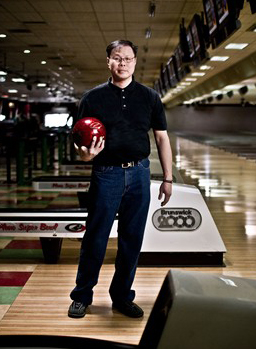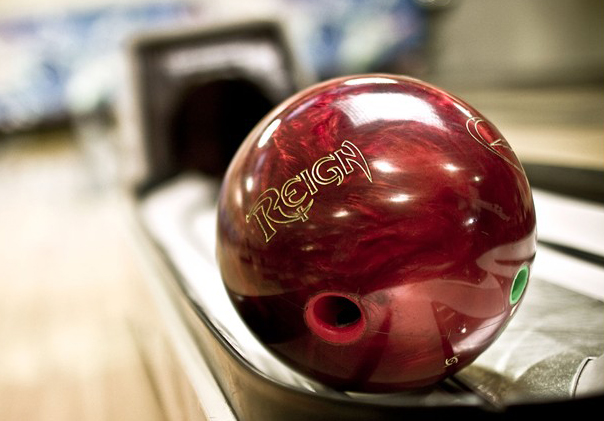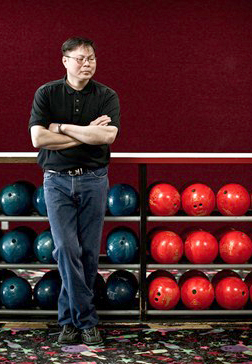In a bowling alley one night, Bill Fong came so close to perfection that it nearly killed him.
When Bill Fong approaches the lane, 15-pound bowling ball in hand, he tries not to breathe. He tries not to think about not breathing. He wants his body to perform a series of complex movements that his muscles themselves have memorized. In short, he wants to become a robot.
Fong, 48 years old, 6 feet tall with broad shoulders, pulls the ball into his chest and does a quick shimmy with his hips. He swings the ball first backward, then forward, his arm a pendulum of kinetic energy, as he takes five measured steps toward the foul line. He releases the ball, and it glides across the oiled wooden planks like it’s floating, hydroplaning, spinning counterclockwise along a trajectory that seems to be taking it straight for the right-hand gutter. But as the ball nears the edge of the lane, it veers back toward the center, as if guided by remote control. The hook carries the ball back just in time. In a heartbeat, what was a wide, sneering mouth of pins is now—nothing.
He comes back to the table where his teammates are seated—they always sit and bowl in the same order—and they congratulate him the same way they have thousands of times over the last decade. But Fong looks displeased. His strike wasn’t good enough.
“I got pretty lucky that time,” he says in his distinctly Chicago accent. “The seven was hanging there before it fell. I’ve got to make adjustments.” With a pencil, he jots down notes on a folded piece of blue paper.

His teammates aren’t interested in talking about what he can do to make his strikes more solid, though, or even tonight’s mildly competitive league game. They’re still discussing a night two years ago. They mention it every week, without fail. In fact, all you have to do is say the words “That Night” and everyone at the Plano Super Bowl knows what you’re talking about. They also refer to it as “The Incident” or “That Incredible Series.” It’s the only time anyone can remember a local recreational bowler making the sports section of the Dallas Morning News. One man, an opponent of Fong’s that evening, calls it “the most amazing thing I’ve ever seen in a bowling alley.”
Bill Fong needs no reminders, of course. He thinks about that moment—those hours—every single day of his life.
• • •
Most people think perfection in bowling is a 300 game, but it isn’t. Any reasonably good recreational bowler can get lucky one night and roll 12 consecutive strikes. If you count all the bowling alleys all over America, somebody somewhere bowls a 300 every night. But only a human robot can roll three 300s in a row—36 straight strikes—for what’s called a “perfect series.” More than 95 million Americans go bowling, but, according to the United States Bowling Congress, there have been only 21 certified 900s since anyone started keeping track.
Bill Fong’s run at perfection started as most of his nights do, with practice at around 5:30 pm. He bowls in four active leagues, and he rolls at least 20 games a week, every week. That night, January 18, 2010, he wanted to focus on his timing.
Timing is everything. When your timing is right, when your arms, legs, and torso all move in rhythm toward the lane, you have better balance. When you’re balanced, you’re also more accurate. And when you’re accurate, your decision-making also improves. By contrast, if your timing is off, your balance is off, and you don’t hit your targets. There are too many variables to assess, too many elements to gauge, and you can’t possibly make the best decisions. Fong knows a hot streak is all about timing. So in practice that night, he breathed, he tried to erase all thoughts, and he tried to make his approach with each body part functioning as programmed.

Only 21 certified perfect series have been rolled. Ever. Bill Fong almost made it 22.
That night, he didn’t roll many strikes in practice. There was nothing to make him think this night would be anything special.
Fong’s team, the Crazy Eights (he picked the name because eights are lucky in Chinese culture), was assigned lanes 27 and 28, one of Fong’s favorite pairs. The left lane, 27, hooks more, he says. The right lane, 28, tends to be more direct.
Frame one was on the left lane. As always, he was last in the bowling order, the anchor position. He watched his teammates roll and noticed each one throw a ball that hooked early and missed the pocket, the sweet spot between the head pin and the three pin on the right, the place that gives you the best chance of getting a strike. So when it was Fong’s turn, he opted to roll a deeper hook, to stay outside and ride the edge of the gutter a little longer.
The result was a loud, powerful strike. His ball slammed into the pocket with a vengeance, obliterating all 10 pins. His next roll, on 28, was another violent strike. All four of the first frames were robust strikes, actually. But his teammates barely took notice.
“To tell you the truth, that wasn’t that unusual,” says JoAnn Gibson, a sweet Southern woman who enjoys the company more than she does the actual bowling.
“Bowlers like Bill can roll off mini-streaks like that all the time,” says Tom Dunn, a more serious bowler who sometimes flirts innocently with JoAnn.
Both Gibson and Dunn have bowled with or against Fong in this league since the Clinton administration. They’ve been teammates for nine years. James Race, who, with his perpetual smile and polite demeanor, reminds the other teammates of Mister Rogers, came a few years later. They don’t really hang out much outside the bowling alley, but no matter what’s going on in life, they go to Plano Super Bowl for a few hours on Monday nights.
Fong’s fifth roll of the night wasn’t so beautiful. His approach and release seemed the same—he was becoming the robot—and the ball hit the pocket, but the pins didn’t go down quickly. The 10 pin was wobbling upright, teetering, when Fong got what is called a “messenger.” From the left, one of the pins he’d just sent bouncing came back across the lane, clipping the 10 just enough to knock it off balance. When he got back to the table, his teammates congratulated him, but Fong called it what it was: a lucky strike.
In the sixth frame, he had another loud, devastating strike. Then another. Then another. With each throw, he could tell it was a strike from the moment it left his hand. He’d watch as the pins were there one second, then gone the next. “It felt like driving and catching a green light, then the next one, then the next, then turning, and still catching every green light everywhere you go,” Fong says.
Before he knew it, it was the 10th frame. Back on the right lane, he again tried to swing the ball wide, let it run along the outside of the lane, next to the gutter. The first two rolls of the 10th frame both tucked into the pocket just as Fong hoped, and both were solid strikes.
On the last roll, though, something happened. He could tell from the sound of the pins. As the clutter at the end of the lane cleared, he could see the nine pin (the second from the right on the last row) still standing. He watched the chaos of the flying pins, each rotating right past the upright nine. Fong craned his neck, watching, hoping. Until one of the pins popped up from its side and swiped the nine down.
“The best way to describe the first 300 was just ‘powerful,’” Race says.
One of the Super Bowl employees announced Fong’s name and score over the loudspeaker, something Fong is a particular fan of. There was a round of applause.
“Sometimes, when you have a lot of 300s, or if you get more than one in a week, they won’t announce it,” he says.
The night was just beginning.
• • •
Aside from bowling, Bill Fong hasn’t had a lot of success in life. His Chinese mother demanded perfection, but he was a C student. He never finished college, he divorced young, and he never made a lot of money. By his own account, his parents didn’t like him much. As a bowler, his average in the high 230s means he’s probably better than anyone you know. But he’s still only tied as the 15th best bowler in Plano’s most competitive league. Almost nothing in life has gone according to plan.
He likes to say he got his approach to bowling from the hard-hitting alleys in his native Chicago, where he went to high school with Michelle Obama. He was one of the few kids from Chinatown interested in bowling at the time. Despite his strict mother and the fact that his friends were all on the honor roll, little William preferred sports. He dreamed of being a professional athlete one day. He wasn’t big—too short for basketball, too slender for football—but he’d run up and down the block as a boy, racing imaginary friends.
When Fong was young, his parents divorced. He remembers the man who would become his stepdad taking his mom out on dates to a local bowling alley, where they could bring the kids. He noticed that when he was bowling, he wasn’t thinking about whatever was going on behind him. His mind could focus on the ball, the lane, the pins—and the rest of the world would disappear. He had never been captivated by anything like that.
While still courting Fong’s mother, his stepdad promised that if the boy ever got a score higher than 120 he’d buy him his own ball. “He never did,” Fong says. “I bought it myself.”
After his mother remarried and moved away, he still had his siblings, his quiet, hard-working father, and his bowling. He joined the high school team. He went to the public library and checked out stacks of books about bowling theory. After a stint in college, he found himself smoking a lot of pot and staying out all night bowling, trying to hustle people out of small bets. He’d leave the alley after the sun came up, go out to breakfast, sleep until 6 pm, and then repeat the process.
At 22, he got married and his wife encouraged him to “grow up.” He realized he wasn’t ever going to become a professional bowler like the men he watched on TV every week, and he took a job cutting hair.
“It was just something I could always do for money,” he says. “I like the artistic side, but it’s not my passion.”
Soon he gave up bowling and took up golf. It was a lot like bowling—timing, balance, accuracy—and he’d heard that with 10 years of practice, anyone could become a top-level golfer. He read books about golf, took a job at a pro shop, and learned to cut his own clubs. For 10 years, through career changes, through his divorce, through his move to Dallas (several family members had moved to Texas for various reasons and he’d always enjoyed visiting), Fong played golf. His younger sister was by then a standout on the Baylor University golf team. But after all those years of playing nearly every day, he still wasn’t a scratch golfer. He couldn’t take the frustration, and he swore off the game for good.
He remembered how much he’d enjoyed bowling. He didn’t miss the up-all-night-gambling lifestyle, but the game itself, shutting out the world and making himself robotic—those things he missed. He joined a few leagues and bowled in tournaments all over North Texas, but no alley felt to him quite like the Super Bowl in Plano. There’s something about the friendly faces, the way a great strike sounded there. It felt right.
After 14 years, he knows all 48 lanes. He equates it to the way Tiger Woods knows the holes on his home golf course. Fong has rolled on each of these lanes dozens of times over the years, and he keeps detailed records.
“No two lanes are the same,” he says.
He documents which lanes hook better and which seem to suck the ball into the gutter. He notes any tiny divot and nearly imperceptible slope, any imperfection he can find. Lane five, for example, has a higher strike percentage when people throw straighter. On lane 16, the oil tends to swirl closer to the pins.
In the years she’s known Fong, Gibson has had very few conversations with him that didn’t involve ball movement and oil patterns, though she admits most of the technical bowling talk flies right over her head. But she smiles, not wanting to offend anyone. “This really is Bill’s life,” she says.
“Looking back,” Fong says, “I guess bowling just always filled whatever emptiness I had.”
• • •
That night, people were still coming over to congratulate Bill Fong on the 300, when he did something unimaginable: for his second game, he switched bowling balls.
He remembered, two weeks earlier, practicing on lanes 27 and 28. He remembered that after a few games, the oil pattern on the right lane shifted. So to start game two on the right lane, he switched to his more polished ball, the one that hooks less and rolls straighter.
Someone on another lane saw him making the change. “Is Bill Fong switching balls?” the man called out to his friends incredulously.
Fong heard him and turned around.
“Yep,” he said.
The man called back to him: “You’re crazy!”
Fong grinned and turned back toward the lane. He stepped forward and unleashed a solid, thorough strike—his 13th of the night. Then he stood there, arms wide, shaking his head. His gutsy move had paid off.
Dunn remembers the feeling in the air. “Because he started out by switching balls, and that was so incredible, the second game was definitely more emotional,” he says.
Throughout the second game, Fong continued using his more aggressive ball on the left lane, and the more polished, less aggressive ball on the right lane. And the strikes kept coming.
It seemed like even members of the other team were smiling when Fong was up to roll. Fong himself was laughing and smiling, pointing and calling out to friends at other lanes. He remembers shrugging a lot. “I felt loose as a goose,” he says.
As he sent strike after strike down the lanes, he began to feel magical. Literally, the way he was commanding the balls to turn and burrow into the unsuspecting pins, it felt a little like he was moving heavy objects with only the power of his mind. In the fourth frame, both the seven and the 10 pins stayed up just a bit longer than he wanted. As he gestured with both arms, they fell. Something similar happened in the eighth frame.
“It was like Moses parting the sea,” he says. “I’d move my hands and everything would get out of the way.”
Soon the other bowlers began stepping back when he was up, taking extra precaution not to get in his way. “Nobody wants to mess up a streak like that,” Dunn says.
By the 10th frame, Fong found that most people around him wouldn’t make eye contact for fear they would be the last thing he would see before rolling a dud. On the first roll of the last frame, he had what he calls a “happy accident.” For the first time that night, one of his powerful throws missed its mark ever so slightly. But because the oil was now evaporating on the left lane, too, the ball found the pocket for a perfect strike. Noticing what happened on the first roll, he adjusted his position and finished the game with two more powerful strikes, Nos. 23 and 24 of the night.
Once again, Fong got to hear his name called from the speakers. And again he took a moment to shake hands with the line of people waiting to congratulate him. A few were embarrassed that they hadn’t come over after the first 300. People were delightfully confused, shaking their heads as they patted Fong on the back.
“Never seen anything like it,” they said. “Back-to-back 300s.”
And Fong shook his own head. “Me neither,” he said.
• • •
There’s almost never a time when every decision you make is correct and every step is in the right direction. Life, like bowling, is full of complicating factors, unpredictable variables, plenty of times when there is no right answer. But Bill Fong had some experience with near-perfection prior to the night. He’d had another amazing run two years before that. He’d bowled a 297, then a 300. Someone mentioned to him that with another great game he could beat the Texas state series record, which was 890. Fong can admit it now: he choked in that third game. He could feel himself thinking too much, slipping out of the zone. Soon he was out of rhythm and his balance was off. That night he shot a 169 in the last game; he didn’t even break 800 for the series. It was exactly what he was trying to avoid after his two straight 300s.
So this time, before game three, he approached a friend who was bowling a few lanes down. Fong mentioned that he was thinking about switching balls again, using the less aggressive ball on both lanes in the final game. His friend, who had plenty of 300s under his own belt, was surprised but gave him simple advice: “Trust your instinct.”
When that first roll of the third game produced another strike—another risky decision rewarded—Fong felt like he was floating. He wasn’t drinking, but he felt a little drunk. Both his teammates and his opponents bowled as fast as they could to get out of his way. By the time he struck in the fifth frame, he realized he would almost certainly break the coveted 800 mark. He was relieved.
By the sixth frame, a large crowd had formed behind Fong. Dozens of people had stopped bowling to watch. Texts were sent and statuses posted to Facebook, and the audience grew.
“We were more nervous than he was at the time,” Gibson says. “It was almost like he was putting on a show up there.”
Each time he approached the lane, the entire bowling alley went silent. Every time he let fly another roll, there were audible moans from strangers and shouts from the crowd: “That’s it, baby!” Each time he struck, the room erupted with applause. In all his life, Bill Fong had never heard anyone cheering him like that.
He had 33 straight strikes entering the 10th frame of the third game. Out came the cell phone cameras. There were whispers, but as soon as Fong picked up his ball, it was dead quiet. He turned to look at the crowd behind him, now well over 100 people, densely packed from the end of the snack bar to the vending machines 80 feet away.
That’s when the magic left him. Fong began to feel nervous, like the world was watching him pee. He felt the buzz—whatever it had been—leave his body. As he stood in front of lane 28, he felt numb. He tried to push through it.
He lined up and threw a ball without much hook on it. As soon as it left his hand, Fong began waving at it, trying to will the ball left. It connected with the pocket but without the usual force. As the other pins dropped, the nine pin stayed up for what seemed like ages. But just as the gasp of the crowd reached a crescendo, one of the pins rolling meekly across the lane bumped the nine just enough to tip it. The room exploded with cheers and whistles. The sound was enough to shake one of the cameras now capturing the moment.
Fong looked dizzy as he walked back to the ball exchange. For the first time that night, he began sweating profusely. But he realized the mistake he’d made on his last throw, and the second roll was much cleaner. Again there were shouts from the audience as the ball blazed down the lane, zipping back in time to smash the pins apart in a powerful, driving strike. And there was even more cheering as all 10 pins fell. Thirty-five strikes down, one to go.
Before his final roll, Fong wiped his ball with his towel. He heard a woman’s voice behind him, a stranger, saying, “We are having fun, aren’t we?” He lifted the ball to his chest and stood calmly for a moment. Then he took five steps and released the ball toward perfection.
It looked good from his hand, arcing out the way so many of his great strikes that night had, cutting back to the pocket just in time. Several people started applauding before the ball even reached the end of the lane—that’s how good it looked. But this time, as the pins scrambled, something unimaginable happened. The 10 pin, farthest to the right, wobbled. But it didn’t fall.
Some of the people in the room couldn’t process what they’d just witnessed. How could the last roll, like the 35 before it, not be a strike?
Strangers fell to their knees. It was hard for anyone to breathe.
Fong turned and walked to his right. He was empty. Blank.
His friends, the ones who were prepared seconds ago to tackle him in celebration, grabbed him and held him still. As he stood there, Fong wanted to say something—anything—but he couldn’t make a sound.
• • •
Sitting around the table two years after that night, Bill Fong and his teammates still argue. Fong truly believes that the last pin could have made his life perfect. “It would have made all the difference,” he says. With a 900, he theorizes, he might have made SportsCenter, and he would surely have sponsors. He thinks he might have had a chance to join the pro tour. At least, he figures, he’d be the best of all time at something, with the name Bill Fong immortalized above even the legends of the game—and he wouldn’t be just a regular guy.
“That pin makes me like the Rodney Dangerfield of bowling,” he says. “I get no respect.”
He goes over that last roll in his mind all the time. He watches the shaky cell phone video.
“It looked so good as it left my hand,” he says.
When that 15-pound sphere collides with the pins, so many things happen so fast that there’s no way of knowing exactly what went wrong in those milliseconds.
That hasn’t stopped Fong from searching for some reason. He wonders if he could have practiced more. He blames the 10 years he was away from bowling. Like that single pin represents the Bowling Fates punishing him for his insolence.
One man, an opponent of Fong’s that evening, calls it “the most amazing thing I’ve ever seen in a bowling alley.”
His teammates disagree. They don’t think that pin would have made much of a difference in Bill Fong’s life at all. What he did was amazing, something that will come up in conversation around the Plano Super Bowl for years.
“It was mind-boggling,” Gibson says.
The fact that he missed perfection by the last pin on the last roll—that makes the whole thing more human, less robotic. And that, somehow, makes it seem almost beautiful. Besides, they argue, Fong still holds the Texas state record. And because there have been only 21 perfect 900s, he is technically tied for the 22nd greatest night in the annals of bowling history. (There have been only 11 899s.)
His life is also better now. Around the time of the 899, Fong got a part-time job at the pro shop at the Super Bowl. Recently, he opened his own place down the road, Bowling Medic Pro Shop. A lot of people from his four leagues come by to have him drill their balls. Sometimes he cuts their hair, too.
There’s also this: that night, after the 899, his friends bought him a few beers. He doesn’t usually drink, but at the time, he felt like the best day of his life had just turned into the worst. After a beer or two—and at least an hour of excited congratulations from strangers—he felt dizzy. When he got home, he went into the bathroom and vomited in the toilet. The walls were spinning.
It turns out Bill Fong was having a stroke. With the stress, the tension of the night, his already high blood pressure had surpassed dangerous levels. Not long after, he had another stroke. When the doctor saw the scar tissue and heard about the night of dizziness, he explained to Fong that he had suffered what could very easily have been a fatal stroke. That night at the bowling alley, had things gone differently, he could have died.
It also means that with the sweating and dizziness he was feeling in the third game, it’s likely that Fong bowled the last few frames through the beginning of that stroke—which makes the accomplishment that much more amazing.
When he had his heart surgery, he was in the hospital for a week. Not many family members visited him. Nobody came from his haircutting days. But he didn’t lack for visitors. Plenty of people from the bowling alley took the time to see him, not just teammates but also some longtime opponents. They asked him how he felt and encouraged him to get well quickly. And, one by one, they each mentioned that incredible night in January, when Bill Fong fell just one pin short of perfect.
Rehab was hard at first. The strokes took a lot of his strength. But within a few months—earlier than doctors recommend—Fong was back to his usual form, back to rolling five days a week. More recently, he’s been sharper than ever. Since that night, Fong has rolled 10 more 300s and four series of at least 800.
As they’re talking about that night, one of his teammates poses the question: wouldn’t Fong rather be alive with an 899 than dead with a 900? It’s really a rhetorical question, but Fong takes a moment to consider it seriously. It takes him awhile, but eventually Fong says he’d rather be alive.
“Well,” says Race, the Mister Rogers of the group, “we’re sure happy to have you still here and bowling with us.”
Tonight, Fong struggles through the first few games. But in the final game of the night, he starts with three straight strikes. Then a fourth. Then a fifth. In the sixth frame, he throws it well but leaves the 10 pin standing, taunting him.
After picking up the spare, Fong comes back to the table, shaking his head and looking at his teammates.
“I’ve got to make adjustments,” he says, and he begins making notes.








